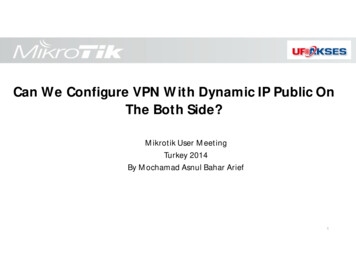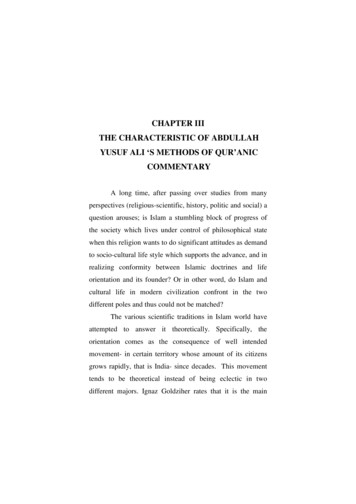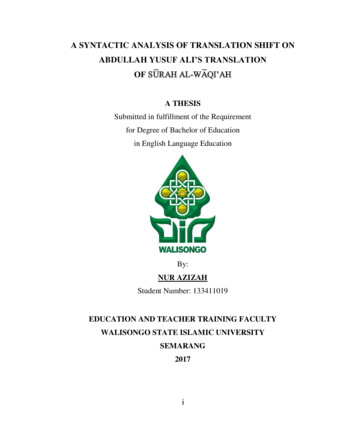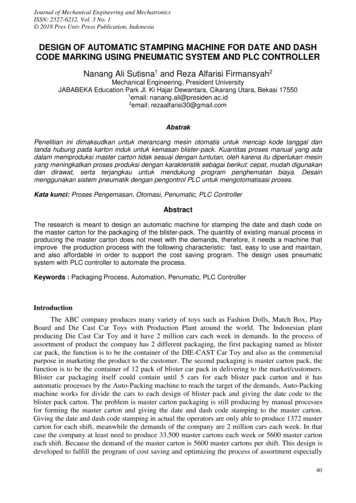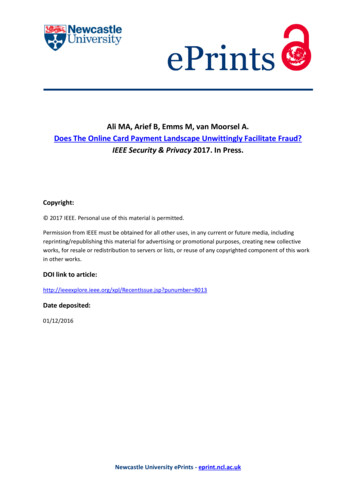
Transcription
Ali MA, Arief B, Emms M, van Moorsel A.Does The Online Card Payment Landscape Unwittingly Facilitate Fraud?IEEE Security & Privacy 2017. In Press.Copyright: 2017 IEEE. Personal use of this material is permitted.Permission from IEEE must be obtained for all other uses, in any current or future media, includingreprinting/republishing this material for advertising or promotional purposes, creating new collectiveworks, for resale or redistribution to servers or lists, or reuse of any copyrighted component of this workin other works.DOI link to .jsp?punumber 8013Date deposited:01/12/2016Newcastle University ePrints - eprint.ncl.ac.uk
Does The Online Card Payment LandscapeUnwittingly Facilitate Fraud?Mohammed Aamir Ali, Budi Arief, Martin Emms, and Aad van MoorselAbstract—This article provides an extensive study of thecurrent practice of online payment using credit and debit cards,and the intrinsic security challenges caused by the differences inhow payment sites operate. We investigated the Alexa top-400online merchants’ payment sites, and realised that the currentlandscape facilitates a distributed guessing attack. This attacksubverts the payment functionality from its intended purpose ofvalidating card details, into helping the attackers to generate allsecurity data fields required to make online transactions. We willshow that this attack would not be practical if all payment sitesperformed the same security checks. As part of our responsibledisclosure measure, we notified a selection of payment sites aboutour findings, and we report on their responses. We will discusspotential solutions to the problem and the practical difficulty toimplement these, given the varying technical and businessconcerns of the involved parties.Keywords—security; online payment; distributedfraudulent transactions; survey; ethical disclosure.attack;I. INTRODUCTIONCards are the de facto means of paying for online purchases.However, as the value of online sales has increased, so hasthe amount of online fraud. As an example, UK 1 onlinesales in 2014 was worth 45 billion, which represents a 16%growth between 2013 and 2014 [1]. In the same time period, thevalue of online fraud in the UK has increased by 33% to 217million [1]. Online fraud is now the single largest category ofcard fraud in the UK, representing 45% of the total value of thefraud committed against UK credit and debit cards [2].In this article, we present the online payment landscape indetail. In particular, we aim to highlight the different manners inwhich online payment is performed, and the varying securitymeasures put in place by online merchants – from checking onlythe card number and the expiry date, to fully-fledged centralisedbank security mechanisms such as 3D Secure [3][4][5]. There isa number of questions we would like to address: does thedifference cause a security problem? if it does, how common isthe problem and can it be exploited? how much damage can bedone? and how could it be resolved in the future? To determinethe extent of the problem, we survey the ‘online paymentlandscape’, creating a mapping of various merchant paymentimplementations.1Sales and fraud statistics from regions other than the UK are less reliable butindicate the same pattern.We came to an important observation that the difference insecurity solutions of various websites introduces a practicallyexploitable vulnerability in the overall payment system. Anattacker can exploit these differences to build a distributedguessing attack which generates usable card payment details(card number, expiry date, card verification value, and postaladdress) one field at a time. Each generated field can be used insuccession to generate the next field by using a differentmerchant’s website. Moreover, if individual merchants weretrying to improve their security by adding more payment fieldsto be verified on their site, they potentially inadvertently weakenthe whole system by creating an opportunity to guess the valueof another field, as explained later in the article.We demonstrate the practicability of exploiting thevulnerabilities with software that implements the distributedguessing attack. We will show that the potential impact of thesevulnerabilities is substantial because the card details generatedby this distributed attack can be used to transfer money from avictim’s bank account to an anonymous recipient overseas usinga financial services company such as the Western Union as aconduit.The vulnerabilities described in this article apply to cardsthat do not enforce centralised checks across transactions fromdifferent sites. Our experiments were conducted using Visa andMasterCard only. Whereas MasterCard’s centralised networkdetects the guessing attack after fewer than 10 attempts (evenwhen those attempts were distributed across multiple websites),Visa’s payment ecosystem does not prevent the attack (seeSection VI.D). Because Visa is the most popular paymentnetwork in the world, the discovered vulnerabilities greatlyaffect the entire global online payments system.We also carried out a responsible disclosure exercise withthe payment sites affected by these vulnerabilities. Of the 342vulnerable websites, we presented our findings to the top-36 ofthese sites (in terms of the severity of the vulnerabilities and thesize of their customer base), monitored their responses, andanalysed the changes these websites have implemented to dealwith our disclosure. Several websites, including some of thelargest and most popular websites in the world, changed theirapproach to online payment processing after our disclosure, aswe will report later in this article. To protect the affected sites,
we refrain from specifically revealing their names and theirvulnerabilities.Finally, we discuss potential solutions to the problem. Wewill see that the vulnerabilities are systemic and cannot beprotected against in isolation by any individual online merchantor by the issuing bank through improving their own securitypolicies. But first, let us look into how current online paymentsystem operates.II. OVERVIEW OF THE ONLINE PAYMENT SYSTEMAn online payment site uses a customer’s existing credit ordebit card to transfer funds from the customer’s bank accountinto the merchant’s bank account. For this to happen, thecustomer needs to provide their card information duringcheckout. These pieces of information are then passed to thecard issuing bank, who will process the information furtherbefore authorising or rejecting the payment request. This processinvolves a number of parties, each with differentresponsibilities.payment page of the online merchant’s website (action A in Fig.1). The merchant controls which data fields are used to authorisethe payment.The merchant then passes the card details to their chosenpayment gateway, which provides a service of authorising andprocessing the merchant’s payment request (action B). Thepayment gateway, on behalf of the merchant, can alsoimplement additional security filters at this point (further detailscan be found in Section VI.C). The payment gateway thenconnects the merchant to the card payment network to requestpayment from the customer’s bank account held at the cardissuing bank. The payment networks (such as Visa andMasterCard) provide the link between payment gateways andthe thousands of card issuing banks (actions C and D).The card-issuer holds the customer’s bank account andmakes the approval of the payment (action E). The issuermaintains customer’s card record file, which containsinformation such as account balance, customer name, fulladdress, and other card details not visible to the rest of thepayment network. In the final step, called a settlement, the cardissuing bank subsequently deposits the customer’s money to themerchant’s bank account (actions F, G and H).B. Payment Card Data FieldsAn online payment is a “card-not-present” credit or debitcard transaction [6]. This implies the merchant cannot physicallyverify that the customer actually has the card. The security ofonline payment is therefore dependent upon the customerproviding data that only the owner of the card could know.The payment card industry has developed a Payment CardIndustry Data Security Standard (PCI DSS) [7], which providesa comprehensive set of rules and controls for the secure handlingand storage of sensitive card data. However, there is norequirement for the merchant to request all of the data fieldsduring an online payment authorisation, nor is there a mandatoryrequirement for the merchant to implement any of the optionalsecurity filters. Five pieces of information are typically usedwhen making an online payment: Cardholder Name: the account holder’s name as printed onthe card. We found that no website checks that a nameentered is correct. 16-digit Card Number: a unique identifier printed on thefront of the card by the issuing bank. Referred to as thePrimary Account Number (PAN), it links the card to thecustomer’s bank account. Card Expiry Date: printed or embossed on the front of thecard. The expiry date and the PAN constitute the minimumset of card authentication data.Fig. 1. Actions and parties in online payment.A. Online Payment Process and Parties InvolvedFig. 1 illustrates the actions and parties involved inprocessing online payments. The process involves thecustomer/cardholder entering their payment card details on the Card Verification Value (CVV2): a 3-digit number printedon the reverse side of the card. It is meant to be known onlyto the person possessing the card. It should not be storedelectronically anywhere in the payment ecosystem [7]. Cardholder Address: not visible on the card but sometimesused for payment authorisation purposes. Addressverification is performed only on the numerical values of thestreet/house and postcode fields; any alphabetical characters
are ignored. Different websites perform varying levels ofverification on the address field’s numerical digits, rangingfrom verifying just the numerical digits in the postcode(partial match), to the complete numerical digits in postcodeplus the door number (full match) [8].III. DISTRIBUTED GUESSING ATTACKTo obtain card details, one can use a web merchant’spayment page to guess the data: the merchant’s reply to atransaction attempt will state whether the guess was correct ornot. The reason this attack works in practice is due to twoweaknesses, each not too severe on its own, but when usedtogether present a serious risk to the global payment system.The first weakness is that in many settings, the current onlinepayment system does not detect multiple invalid paymentrequests on the same card from different websites. Effectively,this implies that practically unlimited guesses can be made bydistributing the guesses over many websites, even if individualwebsites limit the number of attempts.Secondly, the attack scales well because different webmerchants provide different fields, and therefore allow theguessing attack to obtain the desired card information one fieldat a time. To understand how essential the scaling issue is, welook at the differences in websites in some more detail. The datafields that web merchants use can be divided into threecategories: 2 fields: PAN Expiry date (the absolute minimum) 3 fields: PAN Expiry date CVV2 4 fields: PAN Expiry date CVV2 AddressStarting with a valid card number (PAN), to guess the expirydate an attacker can utilise several merchants’ websites thatcheck only two fields: the card number and the expiry date. Oncethe expiry date is known, the attacker can use it along with thecard number to guess the CVV2 information using another setof websites that check 3 fields (the card number, the expiry date,and the CVV2).digits) is not as straightforward as getting the expiry date orCVV2 because first, the attacker will need to narrow down thepossible postcodes of the cardholder’s address. This can be doneby querying the first six digits of a PAN through well-knownonline databases such as BinDb [10] and ExactBins [11], whichwill reveal the card’s brand, issuing bank name, and card type.Once the issuing bank is known, the attacker can increase theprobability of guessing the right postcode by assuming that thevictim is likely to be registered with one of the branches nearby– this is particularly relevant if the attacker uses NFC skimmingto obtain the PAN and expiry date in the first place (see SectionIV.B). Now, the attacker just needs to start brute force guessesfrom a list of issuing bank postcodes for a particular city wherethe card details have been skimmed from.IV. EXPERIMENTSWe implemented a set of software tools to carry out thedistributed guessing attack, using the research team’s own cardsto verify that it is indeed possible and practical to obtain all theinformation of the card. Included are seven Visa cards with aspread of PAN, expiry date, and CVV2 values. We selected 400Alexa [12] top rated commercial websites for our investigation.These include many global websites such as iTunes, Google,PayPal, and Amazon.A. Software ToolsThe software tools implemented for the experiments consistof a website bot and automated scripts written in Java Seleniumbrowser automation framework [13]. All the experiments wererun on Mozilla Firefox web browser. Fig. 2 shows a screenshotof the website bot, which was used to automate the process ofguessing relevant card information. The bot cycles through thepossible values for each field to find the correct information.Guessing an expiry date takes at most 60 attempts (bankstypically issue cards that are valid for up to 60 months), andsubsequently, guessing the 3-digit CVV2 takes fewer than 1,000attempts. Hence, expiry date and CVV2 are guaranteed to beobtained within 60 1,000 1,060 guesses. If all merchantswould use three fields and ask for expiry date as well as CVV2,then it may take as many as 60 x 1,000 60,000 attempts. Thedifference between 1,060 and 60,000 is the difference betweena quick and practical attack, and a tedious, close to impracticalattack.Fig. 2. Screenshot of the website bot, farming CVV2 from multiple sites.For many purposes, knowing the PAN, expiry date andCVV2 is sufficient to use a card online, but for some purchases,an attacker would also need to obtain address information. Toguess address information, the attacker needs to use websitesthat ask for 4 fields. The address field is used in a variety ofmanners, based on the Address Verification System (AVS),which validates the billing address provided by the customeragainst the address information stored by the card-issuing bank[6][8][9]. The process of getting cardholder’s address for thecountries that have a long postcode (more than 3 numericalB. Obtaining Card DataThe PAN is the starting point for the generation of all of theother card data fields. There are at least two known methods ofobtaining valid PANs. Criminals sell bulk lists of card detailsonline. These lists are considered less valuable when they do notcontain the CVV2; nevertheless, such a list could be used as asource of PANs from which the expiry date, CVV2 and addressinformation can be generated. Another method is by exploitingthe contactless feature common in recently issued payment
cards. NFC skimming [14] provides an attacker with the PAN,the expiry date and in some cases, the cardholder’s name. It isalso possible to generate PAN using the first six digits of a PANand the Luhn’s algorithm [15] and getting it verified. However,we did not take this approach because it is crossing the boundaryof ethical research—we only used our own cards.these sites to guess the expiry date. 291 sites use three fields,which one can use for guessing the CVV2, and 25 sites use fourfields, which allows one to guess the postcode of the address.Finally, of the 389 sites, 47 merchants (i.e. 12%) hadimplemented 3D Secure payments (these sites are impervious tothe distributed guessing attack, see Section VI.B).Once the PAN is known, an attempt to obtain the expiry datecan commence. We note that sometimes the expiry date can beobtained at the same time as the PAN, for example by using theNFC skimming method described above. But if that is notpossible, the bot can be used to systematically guess the expirydate of a given PAN on the websites that do not require CVV2to be entered. The next step in card data generation involvesgetting the card’s CVV2. To find the correct CVV2, the bot willsimply need to cycle through the possible values starting from001 until the payment website blocks further attempts. Ahandful of payment sites allowed unlimited attempts while mostof the other payment sites allowed 5, 10 or even 50 attempts toenter a correct CVV2. In our scenario, we “farm out” the bruteforce guessing attack to tens or even hundreds of paymentsystems, which practically means we can carry out unlimitedguesses. The final step generates the cardholder’s address. Anattacker can exploit the different variants of address verificationsystem (discussed in Section III) to find the full address of thecardholder.There is also a variation in the number of attempts allowedat each of these sites, ranging from 4, 5, 10, 20, 25, 50, or evenunlimited. In Table I, the number of sites that allow certainnumber of guesses is shown in the rows, for each type of site (asrepresented in the columns). We see that most sites (276) allowbetween 6 and 10 attempts, but 6 sites set no limit to the numberof attempts. There were two notable outliers to this observationin the top-10 highly popular websites, one of which allowedunlimited attempts to guess the CVV2, while the other requiredonly the 16-digit card number plus the expiry date.C. Transferring the MoneyOnce either two, three, or four fields of the card data havebeen obtained, the attacker can use them to purchase goods on awebsite. This is damaging enough for the owner of the card, butwe looked at even more impactful attacks. Rather than buyingonline goods from an e-commerce website, we created an attackscenario that uses the card details to open a money transferaccount, sends the money to an anonymous recipient abroad,where the money is picked up within minutes of issuing thetransfer. The attacker needs to be able to clear the funds beforethe issuing bank reverses the payment and thwarts the attack. Itis therefore desirable from the attacker’s point of view that thefunds are transferred to an account outside the country (becauseit is more time consuming and costly to reverse payment acrosscountries) or be conducted through a wire transfer to ananonymous cash recipient by using services such as the WesternUnion.In our experiment, the card information extracted using ourbot was used to create a bogus account from which wetransferred money to a recipient in India. Within minutes, wereceived a confirmation email for the order made, and ourcontact confirmed the pick-up of the money. The time it tookfrom the process of creating an account to collecting the moneyat the destination was only 27 minutes, which is short enough toavoid the bank reversing the payment.D. ResultsOur results (detailed in Table I) show that the distributedguessing attack described in Section III is indeed practical andso a credible threat. We studied and tested the payment websiteof 389 of Alexa’s most visited sites (we looked at the Alexa top400 sites, but 11 of them did not reveal sufficient usefulinformation for our experiment). As shown in Table I, 26 sitesuse only two fields for card payment and an attacker would useOur experiments successfully obtained the valid expiry datefor each of our Visa test cards, without exception. We alsomanaged to find valid CVV2 information for our Visa test cards,again without exception. We performed more than 11,000CVV2 iterations using our bot and scripts, and our experimentsconfirmed that there is no centrally imposed limit on the numberof CVV2 attempts when distributing guesses over multiplewebsites. The final step is to obtain the address information. Ourtests performed more than 3,000 iterations on the group ofwebsites that verify partial address (only postcode digits), to getnumerical digits of the postcode. We extended our experimentsand run instances of our bot on another set of payment sites(which verify the door number and the postcode digits) in orderto get the full address of all our Visa test cards.TABLE I.NumberofattemptsallowedVARIATION IN PAYMENT SECURITY SETTINGS OF ONLINEPAYMENTS WEBSITESSiteswith 2fields(guessexpirydate)Siteswith 3fields(guessCVV2)Siteswith 4fields(guessaddresspostcode)Siteswith 3DSecure(safefromattack)Total0 to 52232-276 to 102023818-27611 to 47389These experiments have also shown that it is possible to runmultiple bots at the same time on hundreds of payment siteswithout triggering any alarms in the payment system.Combining that knowledge with the fact that an online paymentrequest typically gets authorised within 2 seconds makes theattack viable and scalable in real time. As an illustration, withthe website bot configured cleverly to run on 30 sites, an attackercan obtain the correct information within 4 seconds.
V. RESPONSIBLE DISCLOSURETwo weeks after we completed the distributed guessingattack experiments, we initiated an ethical/responsibledisclosure exercise, notifying Visa and a selection of affectedsites. Based on the number of fields that a website checks, wecategorised them into three groups: expiry date, CVV2 andpostcode. Since the total number of vulnerable websites wasvery high, we selected the 12 biggest players from eachcategory (in terms of the highest number of users), taking thetotal number of notified websites to 36.Once a suitable contact person or team for each website wasfound, we presented them with the disclosure information thatfeatured the experiments we performed and the type ofvulnerabilities on their site. We used our official work/universityemail address and this served as a means for these merchants totrace us back, so that they can verify our authenticity. Thiswould also allow them to request more detailed and technicalinformation about our experiments should they wish to find outmore.We recorded the responses received from these websitesover the duration of four weeks after we disclosed thevulnerabilities to them. Altogether, we received 20 humanresponses from 10 websites and 18 websites came back to uswith machine generated response mostly confirming the receiptof our notification. All of the human responses requested moretechnical details while some asked us to suggest solutions. Outof the 36 websites we contacted, eight never responded. When aweb merchant requested more information, we offered them aninitial draft of this article, which explained the experiments andthe attack to help them understand the actual problem. Wefollowed the disclosure policy requested by the websites andanonymised the affected sites in our article.TABLE II.NATURE OF PATCHING ON THE NOTIFIED WEBSITESPatching velocityfilter (IPbased)AddingCAPTCHAAExp. date BExp. date CExp. date DExp. date ECVV2FCVV2 GCVV2 HCVV2 As a result of our disclosure process, eight of the 36 websiteschanged their online security settings but the other 28 websitesremained unchanged four weeks after the disclosure. We callsuch changes ‘patches’ in what follows, and Table II illustratesthe nature of the patching of the notified websites. Of the eightwebsites that modified their approach (labelled A to H), fourused two fields (labelled ‘Exp. Date’ in the ‘Information Leak’column) and four used three fields (labelled ‘CVV2’).In most cases, we learned about the patching behaviourthrough manual observations, but in two cases (Website B andWebsite G), the affected websites notified us about the changesthey made. Website A and Website B patched their checkoutsystem by adding an address verification field. However, thiswas not a good idea because it did not provide additionalsecurity, but instead opened up a new avenue for guessing aswill be discussed at the end of this section.Typically, an online payment request is authorised almostinstantly (within 2 seconds). From our observation, we noticedthat Website C and Website D (both with expiry date leak) hadintroduced additional delays to the payment authorisationprocessing times. They did it in a staggered manner: fewattempts were processed instantly but after certain incorrectattempts had taken place, the time taken for paymentconfirmation were increased. In this manner, fewer attemptswere available (at least practically speaking) to enter the rightexpiry date without setting a hard upper bound to the number ofattempts.We found that Website E (one of the Alexa top-10 websitesin terms of the number of visitors) patched their checkout systemby adding PAN velocity filters, reducing the number of attemptsallowed (based on the PAN) from unlimited to 100 attemptswithin 24 hours. Website F followed a similar approach andadded IP-based velocity filter to limit the number of attempts toget CVV2 from 50 to 10 in 24 hours. Initially, Website G andWebsite H added CAPTCHA on their checkout page, thusdisrupting our bot from carrying out the attack. Our experimentprotocol limited the interaction with the administrators ofnotified websites. Due to complex trade-offs that paymentwebsites need to consider when deciding which fields and filtersto use, our ethical disclosure protocol did not volunteer adviceabout what actions to take to deal with the vulnerabilities.However, in one situation we felt we needed to depart from theprotocol, namely in the case of Websites G and H, who added aCAPTCHA. CAPTCHAs prevent automated attempts in gettingthe sensitive card information but may adversely affect theusability of those websites [16]. To help Websites G and H tobetter understand the implications of adding a CAPTCHA, weprovided these two websites with more detailed informationabout the attacks. This resulted in the CAPTCHA being replacedwith IP address velocity filters, which allowed five attempts perIP address in 24 hours (hence a mark in two cells in Table II forthese websites).The overall result of our study on the nature of patching onthe notified websites revealed that the vast majority (78%) didnot make a change. We do not know the reason behind this andfurther research will be needed to find the explanation. Of theeight that patched, the general approach taken by merchants iseither to add a filter to make it more cumbersome to try manytimes (6 of 8 sites that patched added delay or velocity filters),or to add a field (Website A and Website B). Perhapssurprisingly, none of the sites reacted by simply putting a hardlimit on the number of allowed attempts. The effect of thesepatching behaviours is not so obvious. As we already pointed
out, the sensible measure of limiting the number of attempts willnot stop the guessing attack if it is not done on all websites.Furthermore, adding a card validation field may be a reasonableidea for a site for various reasons, but inadvertently may evenweaken the protection against the guessing attack of the paymentsystem as a whole. After all, the added field may be a welcomeopportunity to attempt guesses on this added card detail.VI. THE CHALLENGES IN SOLVING THE PROBLEMImproving the security of the online payment system is acomplicated challenge for a variety of reasons. One could arguethat payment card security mechanisms are bound to remainunsatisfactory since they have not been designed for distributedoperation over the distributed Internet. Many of the solutions,such as 3D Secure can be seen as afterthoughts, and theystruggle to gain widespread adoption. Any suggestedimprovement or solution faces the challenge that the onlinelandscape contains many players that all have their own – attimes competing – incentives for or reasons against change. Anysolution would have to combine technical concerns withfinancial and business operational concerns, and its adoptionwill depend on legal and economic dynamics. We explore anddiscuss these issues from the perspectives of the five partiesshown in Fig. 1.A. Customer / CardholderSince the distributed guessing attack described in this articleuses merchant websites and card payment network to get all thecard details, there is not much a cardholder can do to prevent it.At the same time, the cardholder is severely impacted by theattack: money may be lost, cards may have to be blocked, andthe result is a waste of time and effort and a decreased sense ofsecurity. Arguably, it would be beneficial for cardholders if theycould get organised as a group, or would have representatives invarious bodies, to put pressure on the other stakeholders. As anindividual, cardholders could ‘vote with their feet’ and selectcards from card payment networks that are not exposed to thedistributed guessing attack. At the moment, the payment systemis too complex and non-transparent to expect customers to beable to make such choices.B. Online MerchantOn their own, a merchant can do very little to preventdistributed guessing attacks. All merchants would have to agreeor be forced to use the same number of fields so that the guessingattack cannot be staged as explained in Section III.At the same time, a merchant can avoid being exploited inthe attack either by only using cards that use a payment networkthat is not vulnerable from the attack, or by using 3D Securetechnologies recommended by the payment card industries [7],such as the American Express ‘SafeKey’ [3], ‘Verified by Visa’[4] and MasterCard ‘SecureCode’ [5]. If 3D Secure isimplemented, the card issuing bank is responsible forauthenticating a cardholder before authorising the payment andit monitors the frequency of transactions and the total value ofpurchases for each ca
payment gateway, on behalf of the merchant, can also implement additional security filters at this point (further details can be found in Section VI.C). The payment gateway then connects the merchant to the card payment network to request payment from the customer's bank account held at the card issuing bank.

